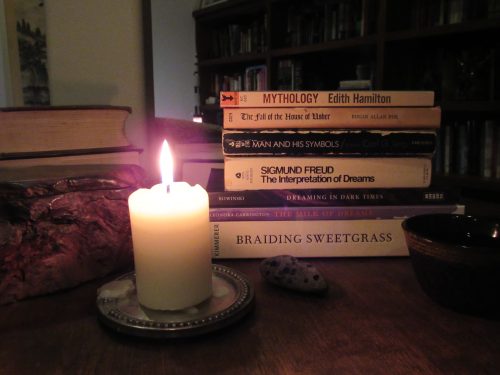 A Dream Library is a playground for studying and dreaming: for studying while dreaming, and dreaming while studying. It’s a spatial technology for stimulating your oneiric imagination. It’s not a shrine to dreaming, but it’s not not a shrine to dreaming, either. It’s your personally crafted portal into the intuitive depths of your own mind.
A Dream Library is a playground for studying and dreaming: for studying while dreaming, and dreaming while studying. It’s a spatial technology for stimulating your oneiric imagination. It’s not a shrine to dreaming, but it’s not not a shrine to dreaming, either. It’s your personally crafted portal into the intuitive depths of your own mind.
What exactly makes a library a Dream Library? What are the essential elements that create a library of dreaming, in all senses of that term? This may seem abstract, but it has potential benefits for anyone who pays attention to their dreams. You can easily create a Dream Library for yourself, and if you do so you’ll find it opens doorways to new dimensions of insight and understanding. There are, in my experience, four essential elements to a Dream Library: books, numinous objects, a cup of tea, and a candle. I’ll describe each in more detail, in reverse order.
A candle: The soft golden light of a candle creates a human-scale sphere of illuminated space. The gently flickering flame brings a dynamic, unpredictable natural force into your presence. Multiple candles can be fun, but one is enough to serve the candle’s essential role in creating a Dream Library. Throughout history the candle has been a classic companion of scholars and sages, symbolizing the enlightenment that slowly emerges from a deep immersion in a collection of wisdom literature. Lighting a candle is a ritual act that opens the Library anew; blowing the candle out is a ritual closing. Of course, a candle with its open flame poses a danger, too (see: Library of Alexandria), so its role in the Dream Library is also to stimulate vigilance and respect for the elemental powers.
A cup of tea: Whether it’s black, green, or herbal, or even some variant of coffee or cocoa, the presence of a hot beverage also plays a vital role. Sure, you might say, but is tea necessary? Is it essential to a Dream Library? Yes, I believe so. Tea can be conceived as an ideal provision for the journey ahead. Entering the Library means a significant commitment of your time and presence. It’s not a quick, in-and-out kind of place. And if you stay there for a while, eventually you will get thirsty. Plain water is fine, but adds nothing atmospherically. A cup of hot tea, however, poured fresh and then brought straight to the Library so the first blooming swirls of redolent steam can fill the immediate surroundings, enhances your experience at many levels. It’s another small but meaningful ritual act that signals a new entry into the Library, and a new commitment to spend time there, to become enveloped for a while within that space. Again, this runs counter to typical library practice, as liquids of any kind can easily damage or destroy books. Water and Fire compete for the title of gravest threat to libraries of all kinds. So you have to be careful. Think about where you can and can’t safely place your cup, stick to that plan, and you’ll be fine.
Numinous objects: This is a broad, potentially infinite category of small material objects that carry special memories, meanings, and values for you. Examples can be a beautiful seashell, a ceramic bowl made by your grandfather, a favorite toy from childhood, or a framed photo of you and a friend on a faraway trip. They can be as simple as a small piece of weathered wood, a cool rock, or an old piece of metal. They can be as elaborate as crystals, antiques, mandala images, and mechanical curiosities. Unusual teacups and candleholders can also double as numinous objects. With this element of a Dream Library, multiplicity matters. The combined effect of these objects is to stimulate wonder and playful curiosity, inviting your mind to wander far beyond the here-and-now, towards distant horizons of exploration and discovery.
Books: There can be no library without books, of course. But for a Dream Library, having books simply means having more than one volume. Two books together already constitute a library. This is a key point: The dynamic vitality of a Dream Library arises from the quality of interaction between books and reader, not the total quantity of books. Naturally, at the center of this Library are various books about dreams. Classic and contemporary, famous and obscure, academic and popular, books you know well and books you hope to read soon. I always suggest including a few texts from Sigmund Freud and Carl Jung, not because they were right about everything (they weren’t), but because they knew so much about ancient dream traditions and expressed those insights in ways that can still enlighten us today. I’d also suggest including your favorite books of all time, not just about dreams. What was your favorite fairy tale from childhood? What novel did you love as a teenager? What non-fiction book has given you a sense of wonder about the world? Those should also be at the Library’s core. You might add other anthologies of fairy tales, other novels by that same author, other non-fiction works on that same topic, thereby expanding and deepening your collection. But again, it’s quality that matters, not quantity. A rich, vibrant Dream Library can have just four or five volumes, if they are the books that speak most powerfully to you.
A Dream Library may be enhanced in other ways, too—e.g., with a comfortable chair, a window with a view, cats. The four elements named here have special appeal because they can be inexpensively acquired, easily transported, and endlessly refined, elaborated, and expanded. Every one of us is a dreamer, and thus everyone can benefit from spending time in a self-created, self-curated library of dreaming.
Note: this post first appeared in Psychology Today, November 30, 2021.

 Of SUVs, prosperous males, and watching witches.
Of SUVs, prosperous males, and watching witches. As a dream researcher, I try to promote public interest in dreaming and its many exciting possibilities. And yet also as a dream researcher, I try to highlight potential problems and misleading claims that can do more public harm than good. This creates a dilemma with the topic of lucid dreaming, which is increasingly popular and yet has pitfalls and drawbacks that its advocates rarely mention or even seem to know exist.
As a dream researcher, I try to promote public interest in dreaming and its many exciting possibilities. And yet also as a dream researcher, I try to highlight potential problems and misleading claims that can do more public harm than good. This creates a dilemma with the topic of lucid dreaming, which is increasingly popular and yet has pitfalls and drawbacks that its advocates rarely mention or even seem to know exist. The Blazers beat the Memphis Grizzlies, 116-96, last Wednesday night, to even their season’s record at 2 wins and 2 losses. They played excellent defense and held Ja Morant, the Grizzlies’ young star guard, to 17 points, half of what he had been averaging the first few games of the season. The Blazers had a strong second half, with more amazing dance-and-shoot moves from C.J. McCollum, who plays with astonishing grace and fluidity. He excels at step-back jumpers, mid-lane floaters, sneaky inside drives, and quick-release 3-pointers, always hunting for the spots where he knows he can elevate and hit his shot. Damien Lillard played well enough on offense to give C.J. room to maneuver, which seems to be part of the season’s overall design. And the bench continues to gain in confidence and cohesion. There was a great play towards the end of the game when Dennis Smith, Jr. took a C.J. Elleby outlet and made a touch pass to Greg Brown for an alley-oop dunk. Everybody loves to see that.
The Blazers beat the Memphis Grizzlies, 116-96, last Wednesday night, to even their season’s record at 2 wins and 2 losses. They played excellent defense and held Ja Morant, the Grizzlies’ young star guard, to 17 points, half of what he had been averaging the first few games of the season. The Blazers had a strong second half, with more amazing dance-and-shoot moves from C.J. McCollum, who plays with astonishing grace and fluidity. He excels at step-back jumpers, mid-lane floaters, sneaky inside drives, and quick-release 3-pointers, always hunting for the spots where he knows he can elevate and hit his shot. Damien Lillard played well enough on offense to give C.J. room to maneuver, which seems to be part of the season’s overall design. And the bench continues to gain in confidence and cohesion. There was a great play towards the end of the game when Dennis Smith, Jr. took a C.J. Elleby outlet and made a touch pass to Greg Brown for an alley-oop dunk. Everybody loves to see that. The day before the opening game of the Trailblazers’ 2021-2022 season, I was bothered by something I read online about Damien Lillard, Portland’s best player. The article ranked him lower among the league’s top players than I think he deserves; it dinged him for his defense, and emphasized the catastrophe that would befall the Blazers should he ever leave. The tone of the article reflected the very low expectations people seem to have for Portland’s performance this season. The Blazers hired a new head coach, Chauncey Billups, who has never held that role before, but whose previous assistant coaching focused on defense, and that’s where the Blazers most needed to improve (tied for 3rd best team in the league in offensive efficiency last year, but 19th in the league in defensive efficiency). Otherwise, Portland made no big roster moves during the off-season. They let Carmelo Anthony go, which I thought was too bad, he had a great run with the Blazers the past couple years. They re-signed their big mid-season acquisition from last year, shooting guard Norman Powell, which is certainly good. They added several new players to the bench, including two big guys who play great defense, Cody Zeller and Larry Nance, Jr.
The day before the opening game of the Trailblazers’ 2021-2022 season, I was bothered by something I read online about Damien Lillard, Portland’s best player. The article ranked him lower among the league’s top players than I think he deserves; it dinged him for his defense, and emphasized the catastrophe that would befall the Blazers should he ever leave. The tone of the article reflected the very low expectations people seem to have for Portland’s performance this season. The Blazers hired a new head coach, Chauncey Billups, who has never held that role before, but whose previous assistant coaching focused on defense, and that’s where the Blazers most needed to improve (tied for 3rd best team in the league in offensive efficiency last year, but 19th in the league in defensive efficiency). Otherwise, Portland made no big roster moves during the off-season. They let Carmelo Anthony go, which I thought was too bad, he had a great run with the Blazers the past couple years. They re-signed their big mid-season acquisition from last year, shooting guard Norman Powell, which is certainly good. They added several new players to the bench, including two big guys who play great defense, Cody Zeller and Larry Nance, Jr. It’s more than a metaphor to say that Halloween is a time when our nightmares go on parade. The scary images, decorations, and costumes that take over the month of October have a direct psychological connection to the actual themes and patterns of people’s nightmares. If we look at current research on nightmares—who has them, what they’re about, what causes them—we can gain new insight into the unconscious creativity of our Halloween festivities.
It’s more than a metaphor to say that Halloween is a time when our nightmares go on parade. The scary images, decorations, and costumes that take over the month of October have a direct psychological connection to the actual themes and patterns of people’s nightmares. If we look at current research on nightmares—who has them, what they’re about, what causes them—we can gain new insight into the unconscious creativity of our Halloween festivities.